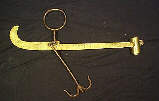Glossary of Old Farming Implements
Thanks to my dad, Joe McCarter, for helping to define a number of these old farm items.
Breast Chains
Light chains attached to the hames and then directly to the front of the wagon tongue so that the inside animal could pull the tongue in the direction of the turn.
Cricket
A cast iron trivet for a smoothing iron that was used for ironing clothes.
Doubletree
A pivoted bar with a whippletree attached to each end, used in harnessing two animals abreast to pull a wagon, plow, etc.
Drawing Knife
A knife with a handle at each end at right angles to the blade, used by reaching out and drawing the blade over surface of the wood and pulling it inward toward the body.
Hames
Two curved pieces lying upon the collar in the harness.
Harness
The leather straps and fittings by which an animal is controlled and attached to
Harrow
A heavy horse or oxen-drawn wooden frame with projecting spikes or teeth for breaking up clods left in a field after plowing. Also used for covering up seeds.
Lines
A set of long leather straps attached to the bridle to guide and control a team of animals pulling a wagon, sled, etc. When riding horseback, these are referred to as reins.
Martingale
Part of the harness consisting of a strap that fastens to the girth, passes between the forelegs and through a loop in the neckstrap or hame, and fastens to the noseband for steading or holding down the animal's head.
Reel
A device with arms around which yarn was wound after it was spun. The reel yielded standard lengths of yarn called skeins.
Scythe
A hand implement with a slightly curved blade at an angle to the handle, used for cutting long grass or grain.
Shovel Plow
A horse or oxen-drawn plow used between rows to create furrows between the growing crops to uproot weeds.
Smoothing Iron
A clothes iron that was heated on a wooden cookstove.
Spider
A trivet or tripod for suspending a cooking pot on a hearth.

Stilyard
A simple, yet accurate scale used for weighing flour, sugar, and other foodstuffs. It consisted of a lever that was notched and graduated in lbs. along its top edge. Its fulcrum consisted of a clevis with a hook at the far left hand side for hanging up on a doorway or tree limb. Another clevis and hook positioned slightly farther to the left of the hanging clevis hung down and this hook was for the item being weighed (often in a sack). A cast iron weight with a long hook was then placed (to the right of the clevis) on the lever and moved along until balance was achieved. The weight of the item was indicated by the graduations. Since a lot of farm goods were traded and bartered the stilyard was a real necessary item in the old days.
Whippletree
A
lso known as a singletree. A crossbar, pivoted at the middle, to which the traces of the horse's harness were fastened for pulling a wagon, sled, etc.